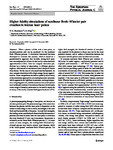Higher fidelity simulations of nonlinear Breit–Wheeler pair creation in intense laser pulses
| dc.contributor.author | Blackburn, TG | |
| dc.contributor.author | King, Ben | |
| dc.date.accessioned | 2022-02-17T13:45:54Z | |
| dc.date.available | 2022-02-17T13:45:54Z | |
| dc.date.issued | 2022-01-17 | |
| dc.identifier.issn | 1434-6044 | |
| dc.identifier.issn | 1434-6052 | |
| dc.identifier.other | 44 | |
| dc.identifier.uri | http://hdl.handle.net/10026.1/18810 | |
| dc.description.abstract |
<jats:title>Abstract</jats:title><jats:p>When a photon collides with a laser pulse, an electron-positron pair can be produced via the nonlinear Breit–Wheeler process. A simulation framework has been developed to calculate this process, which is based on a ponderomotive approach that includes strong-field quantum electrodynamical effects via the locally monochromatic approximation (LMA). Here we compare simulation predictions for a variety of observables, in different physical regimes, with numerical evaluation of exact analytical results from theory. For the case of a focussed laser background, we also compare simulation with a high-energy theory approximation. These comparisons are used to quantify the accuracy of the simulation approach in calculating harmonic structure, which appears in the lightfront momentum and angular spectra of outgoing particles, and the transition from multi-photon to all-order pair creation. Calculation of the total yield of pairs over a range of intensity parameters is also used to assess the accuracy of the locally constant field approximation (LCFA).</jats:p> | |
| dc.format.extent | 44- | |
| dc.language | en | |
| dc.language.iso | en | |
| dc.publisher | Springer Science and Business Media LLC | |
| dc.title | Higher fidelity simulations of nonlinear Breit–Wheeler pair creation in intense laser pulses | |
| dc.type | journal-article | |
| dc.type | Journal Article | |
| plymouth.issue | 1 | |
| plymouth.volume | 82 | |
| plymouth.publication-status | Published | |
| plymouth.journal | The European Physical Journal C | |
| dc.identifier.doi | 10.1140/epjc/s10052-021-09955-3 | |
| plymouth.organisational-group | /Plymouth | |
| plymouth.organisational-group | /Plymouth/Faculty of Science and Engineering | |
| plymouth.organisational-group | /Plymouth/Faculty of Science and Engineering/School of Engineering, Computing and Mathematics | |
| plymouth.organisational-group | /Plymouth/REF 2021 Researchers by UoA | |
| plymouth.organisational-group | /Plymouth/REF 2021 Researchers by UoA/EXTENDED UoA 10 - Mathematical Sciences | |
| plymouth.organisational-group | /Plymouth/REF 2021 Researchers by UoA/UoA10 Mathematical Sciences | |
| plymouth.organisational-group | /Plymouth/Users by role | |
| plymouth.organisational-group | /Plymouth/Users by role/Academics | |
| plymouth.organisational-group | /Plymouth/Users by role/Researchers in ResearchFish submission | |
| dcterms.dateAccepted | 2021-12-17 | |
| dc.rights.embargodate | 2022-2-18 | |
| dc.identifier.eissn | 1434-6052 | |
| dc.rights.embargoperiod | Not known | |
| rioxxterms.funder | Engineering and Physical Sciences Research Council | |
| rioxxterms.identifier.project | Quantum phenomena in high-intensity laser-matter interactions | |
| rioxxterms.versionofrecord | 10.1140/epjc/s10052-021-09955-3 | |
| rioxxterms.licenseref.uri | http://www.rioxx.net/licenses/all-rights-reserved | |
| rioxxterms.licenseref.startdate | 2022-01-17 | |
| rioxxterms.type | Journal Article/Review | |
| plymouth.funder | Quantum phenomena in high-intensity laser-matter interactions::Engineering and Physical Sciences Research Council |


